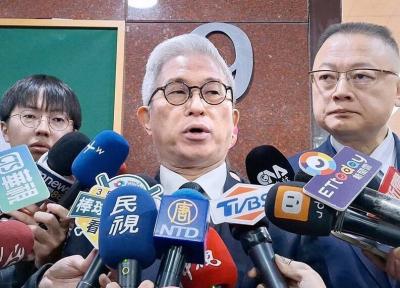When Democratic Progressive Party (DPP) candidates registered for their party’s presidential primary on March 25, each candidate was required to pay a NT$5 million (US$170,000) registration fee.
The price of entry to this year’s competition is hefty — equivalent to buying a Ferrari sports car or a 5 carat diamond.
This initial hurdle to putting one’s name on the ballot is itself an early challenge and provides a glimpse into which candidates have the best organization or the most personal wealth.
For those who have neither, their path to victory looks problematic right from the start.
Former DPP chairman Hsu Hsin-liang (許信良) turned in his registration just before the deadline, saying that it has long been his dream to be president, but being out of the public spotlight for years, the only way he could raise the money to pay the registration fee was by taking out a loan, which he secured only an hour before throwing his hat in the ring.
Hsu said he spent a month trying to gather donations from friends near his hometown of Jhongli in Taoyuan County, but no one was willing to make a donation because nobody thinks he has a chance of winning.
One day before the deadline, Hsu reached out to his brother who tapped his own business connections to obtain the NT$5 million loan. Hsu’s difficulties encapsulate the Catch-22 that faces all underdog candidates. The only way they can raise the money they need is to prove to donors that they are viable through primary campaigning, but they cannot take part in the process without first raising considerable funding
The question is, who would donate such a large sum of money to someone who has yet to prove him or herself?
According to Hsu Chia-ching (徐佳青), spokesperson of another DPP presidential hopeful, Tsai Ing-wen (蔡英文), Tsai paid the entire registration fee with her own money. So did the other DPP presidential hopeful, Su Tseng-chang (蘇貞昌), his spokesman Lee Hou-ching (李厚慶) said. Neither candidate solicited donations.
Collecting a total of NT$15 million from the three candidates, the DPP plans to use the funds to finance their presidential primary process, which includes hosting debates, organizing five telephone polls in April that will determine the party’s nominee and producing party-wide media materials.
“We are a poor party,” DPP spokesman Lin Yu-chang (林右昌) said. “There is no ‘why’ in charging so much. We have always done it this way.”
Nor are these excessive charges typical of just the DPP.
Because primaries are funded entirely in-house, each party must find the necessary resources to finance the process.
“I do think it’s too expensive, but I can’t legitimately say it’s wrong,” Hsu said. “The DPP doesn’t have a lot of resources, so it requires us to pay [for the primary].”
The Chinese Nationalist Party (KMT) plans to charge candidates a NT$2 million refundable deposit for filling out a registration form, as well as a NT$7 million non--refundable fee if someone steps up to challenge President Ma Ying-jeou (馬英九) for the nomination. Ma paid NT$7 million when he filed for his last primary in 2007.
National Sun Yat-sen University’s Institute of Political Science director Liao Da-chi (廖達琪) said that by charging such high registration fees, the parties are able “to prevent any granny from running for president.”
Unfortunately, it also narrows the field too much.
“Such high fees only allow certain qualified people to enter the political arena,” Liao said. “Politics in Taiwan is really a game for the rich. It’s very undemocratic.”

Taiwan is to commence mass production of the Tien Kung (天弓, “Sky Bow”) III, IV and V missiles by the second quarter of this year if the legislature approves the government’s NT$1.25 trillion (US$39.78 billion) special defense budget, an official said yesterday. Commenting on condition of anonymity, a defense official with knowledge of the matter said that the advanced systems are expected to provide crucial capabilities against ballistic and cruise missiles for the proposed “T-Dome,” an advanced, multi-layered air defense network. The Tien Kung III is an air defense missile with a maximum interception altitude of 35km. The Tien Kung IV and V

The disruption of 941 flights in and out of Taiwan due to China’s large-scale military exercises was no accident, but rather the result of a “quasi-blockade” used to simulate creating the air and sea routes needed for an amphibious landing, a military expert said. The disruptions occurred on Tuesday and lasted about 10 hours as China conducted live-fire drills in the Taiwan Strait. The Civil Aviation Administration (CAA) said the exercises affected 857 international flights and 84 domestic flights, affecting more than 100,000 travelers. Su Tzu-yun (蘇紫雲), a research fellow at the government-sponsored Institute for National Defense and Security Research, said the air

A strong continental cold air mass is to bring pollutants to Taiwan from tomorrow, the Ministry of Environment said today, as it issued an “orange” air quality alert for most of the country. All of Taiwan except for Hualien and Taitung counties is to be under an “orange” air quality alert tomorrow, indicating air quality that is unhealthy for sensitive groups. In China, areas from Shandong to Shanghai have been enveloped in haze since Saturday, the ministry said in a news release. Yesterday, hourly concentrations of PM2.5 in these areas ranged from 65 to 160 micrograms per cubic meter (mg/m³), and pollutants were

Taiwan’s armed forces have established response protocols for a wide range of sudden contingencies, including the “Wan Chun Plan” to protect the head of state, the Ministry of Defense (MND) said today. After US President Donald Trump on Saturday launched a series of airstrikes in Venezuela and kidnapped Venezuelan President Nicolas Maduro, concerns have been raised as to whether China would launch a similar “decapitation strike” on Taiwan. The armed forces regularly coordinate with relevant agencies and practice drills to ensure preparedness for a wide range of scenarios, Vice Minister of National Defense Hsu Szu-chien (徐斯儉) told reporters before a